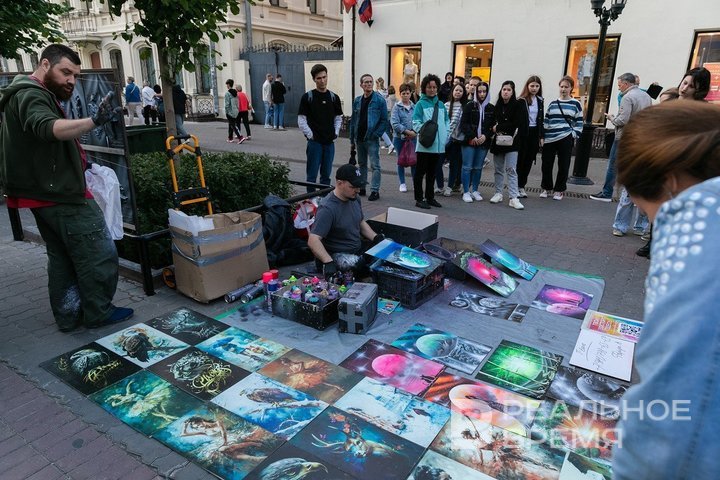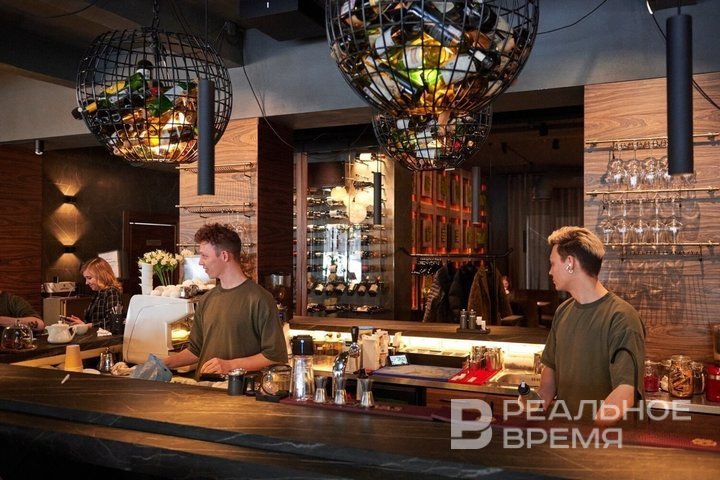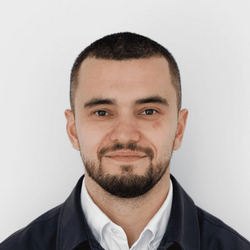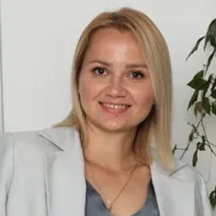Why Tatarstan lags behind in the ranking of Russia’s creative regions
The reason is the absence of a unified centre responsible for the development of the sector in the republic, experts explain

The Ministry of Culture of Tatarstan has been tasked with creating a registry of citizens and organisations working in the field of creative industries. As of this year, it is considered a separate and important sector of the economy. It refers to the sale of goods and services attributed to intellectual activity — that is, entrepreneurs who earn through their creativity. The Russian government plans to increase the sector’s contribution to the country’s GDP from 4.1% to 6% within five years. It is difficult to say what share the republic will contribute, since it has dropped out of the top five strongest regions in the national index and is no longer among the top ten. Realnoe Vremya has looked into the reasons behind this and the prospects for market growth.
What are the creative industries
Tatarstan will establish a registry of representatives of the creative industries. The relevant directive has been issued by the republic’s prime minister, Aleksei Pesoshin, to the regional ministry of culture. According to the document, the ministry will be required to update the list and regularly verify that each entry genuinely belongs to the sector.
The creative industries are a sector of the economy directly linked to the creation, promotion in domestic and international markets, distribution and/or commercialisation of a creative product that possesses uniqueness and economic value.

According to the Creative Economy Autonomous Non-Profit Organisation, this sector includes 16 areas: design; IT and software development; computer graphics and animation; architecture and urban planning; education; children’s games and toys; research and development; gastronomy; film and video; art and applied decorative arts; video games; media and advertising; fashion; literature and writing; performing arts; music and sound design.
According to the Russian Ministry of Economic Development, the creative industries market has reached 7.5 trillion rubles, accounting for 4.1% of the country’s GDP. Over the past three years, the market has grown by 3 trillion rubles. This was stated by Russia’s Minister of Economic Development, Maksim Reshetnikov, during a strategic session dedicated to the development of the creative economy. According to him, the top three contributors are the IT sector (34.96% of the market), advertising and PR (13.38%), and gastronomy (10.6%).
The goal is to increase the sector’s share of GDP to 6% by 2030,” Maksim Reshetnikov emphasised.

Tatarstan has everything — yet experts dropped it from the top 10
In the annual Regional Creative Industries Index compiled by the Higher School of Economics (HSE), Tatarstan ranked only 14th in 2024, a sharp fall from fifth place the previous year. The index is based on four criteria: the region’s socio-economic conditions, the state of its cultural environment, the state of the creative industries' economy, and the level of support for the sector. While the republic improved its standing in the first two categories, experts gave low marks for the condition of the creative economy and the level of institutional support.
At the same time, Tatarstan ranks sixth among regions with million-plus cities and a level of creative industries development “above the national average.” Ahead of it are Moscow, St Petersburg, and the Novosibirsk, Sverdlovsk and Nizhny Novgorod regions. However, the republic holds third place among all regions — behind Novosibirsk — in terms of the average salary in this sector, where earnings “exceed the average for the economy.”
Experts behind the index highlighted several of the region’s strengths: active training of creative industry professionals, a positive rate of creation and registration of intellectual property, investments in the development of digital technologies, and the presence of dedicated organisations supporting the growth of creative industries.
As the Higher School of Economics told Realnoe Vremya, there were two reasons behind Tatarstan’s drop in the national ranking:
- The transition from the old HSE classification of creative industries to a new one, which now includes not only creative industries themselves but also related sectors.
- As of June 2024, the absence in the republic of a dedicated institution for the development of creative industries, as well as a lack of positive dynamics — compared to other regions — in the number of creative industry organisations attracting federal support measures.

According to the Tatkultresourcecentre portal, established by the regional ministry of culture, the republic operates in 12 areas (some of which are grouped): performing and theatrical arts; advertising and marketing; film, video and photography; television and radio; design — product, communication and fashion; publishing; IT, software and games; visual arts; museums, galleries and creative clusters; architecture; music; and crafts.
There is no consolidating body in Tatarstan — yet the situation is not bad
Igor Namakonov, director general of the Federation of Creative Industries (FCI), provided Realnoe Vremya with a detailed analysis of Tatarstan’s position in the creative industries sector. According to him, after the federal study “100 Creative Leaders of Russia” was conducted in 2020, our republic was the first to take the initiative to adapt this research at the regional level.
The monitoring conducted revealed an impressive concentration of talented authors and creative entrepreneurs, predominantly centred in Kazan. This aligns with the overall trend in the development of creative industries in Russia, where major cities serve as hubs for the concentration of resources, human capital, and markets for creative products.

Naturally, despite generally favourable conditions for the creative industries in the region, it remains difficult to understand who to communicate and collaborate with on the topic, the expert added. “At the same time, there is a small city in Tatarstan — Almetyevsk — which has been hosting the industry forum Almet Creative Days for several years, and boasts an impressive city festival, Karakuz (essentially a creative industries festival). It is also home to the largest creative industries school in the country. In this one city alone, several organisations were involved in creative industries. Last year, they managed to unite. I visit Almetyevsk more often than Kazan — precisely because there is a clear development centre and people responsible for the sector,” he explained.
According to the federation, the most developed sectors in Tatarstan are the IT industry (especially software development), the music industry, the media sphere, theatrical arts, and publishing.
Videographers, having learned the craft, leave for Moscow because that is where the market is
Roman Korolev, head of the video production company Kingof media, co-founder of the film company Vechny Ogon and the creative association KAEN, considers Tatarstan a conservative region in terms of working with production companies. According to him, the republic has three or four major players and numerous smaller ones, each of whom has found their niche, built a client base, and comfortably operates year after year. However, in his view, it is premature to speak of a fully developed and established video production sector in the region.
“In Tatarstan, most large companies like KAMAZ, for example, often placed orders with Moscow-based firms because they believed they were more professional, while smaller companies always tried to save money,” Korolev said confidently.
Another challenge faced by this sector is the relocation of specialists. This is not only due to moves caused by the start of the special military operation but also reflects a broader trend: as soon as a specialist becomes established, they move to Moscow.
“The very first thought they have is: I need to go to Moscow. Let’s be honest — Moscow is the only city where there really is a commercial video industry. There is a market, and therefore there is work. Many excellent specialists leave in entire teams. We don’t have a market; we just have a small group of people who know how to do it well,” Korolev stated.
According to the expert, the video content market is also undergoing a transformation due to the emergence of accessible neural networks. The mass migration of specialists into content generation has led to a sharp decline in prices.

However, the expert predicts a market slowdown in about a year. Meanwhile, small production companies focused on small businesses, he says, risk not surviving until the end of the year.
Problem with gastronomy — authorities are shy of bars, while tourists are looking for them
Valeriy Plikhta, co-founder of Make More Group (More Bar, Utro Cafe, Zero Bar, Skazki o Solntse restaurant), noted that Tatarstan and Kazan, regardless of their status as the “gastronomic capital of Russia,” have seen growth in the number of outstanding projects in the gastronomy sector in recent years. According to him, Kazan tends to focus on restaurants and cafes, overlooking the fact that bars are also part of the gastronomy segment and are of interest to tourists, who come not only to eat. On this issue, Plikhta suggests following the example of St Petersburg, which once embraced the idea of being the “bar capital of Russia.”


According to him, besides losing its unique gastronomic landscape, Kazan could also lose part of the tax revenue from wages paid by local establishments to their employees, who in turn spend their earnings within the region.
Another challenge faced by local players is a shortage of staff, which is partly related to the organisation’s HR brand. How to address this issue remains an open question. However, when asked about the need to create a gastronomy institute for training personnel — similar to the one existing in Krasnoyarsk — Plikhta responded that if such an institution is to be established, it should be funded by a commercial entity rather than through public funds.
There are plenty of IT specialists, but they need a ‘union’

The interlocutor notes that his field does not face staffing issues. This is partly due to the quality education provided by Kazan Federal University and Innopolis University, as well as online courses in IT professions. In fact, because of the latter, the market is somewhat overheated with beginner specialists. At the same time, it is premature to talk about IT professionals soon being replaced by artificial intelligence. AI still requires a real person — a professional prompt engineer — to give it commands. The reason is simple: even the best AI assistant tends to “imagine.”
Architecture, despite its fundamentality, is part of the creative economy


Ministry of culture sees growth in light industry and jewellery art
According to Irada Ayupova, Minister of Culture of Tatarstan, the decision to create a registry of representatives of the creative industries was driven by the requirements of Federal Law No. 330 “On the Development of Creative Industries in the Russian Federation.” The document provides for the establishment of such a registry to clarify the list of players, the necessary support measures, and infrastructure development.

“But this is also a story connected to the overall level of development of a particular region, its economic structure, and the trends in the development of creative industries within that region. Currently, a methodology for calculation is being formed. From my point of view, it is more important to focus not on indices, but on official statistical data. It is necessary to build infrastructure that allows individuals to monetise their intellectual and creative potential,” Irada Ayupova noted in an interview with Realnoe Vremya.
One of the infrastructure facilities expected to give a boost to the entire creative industries sector will be the renovated Kazan Central Department Store. However, even without it, there are already several such facilities. These include the new G. Kamal Theatre, the National Library of the Republic of Tatarstan, and the IT Park. According to Ayupova, among the areas of the creative economy that Tatarstan would do well to strengthen are the light industry sector and jewellery art.